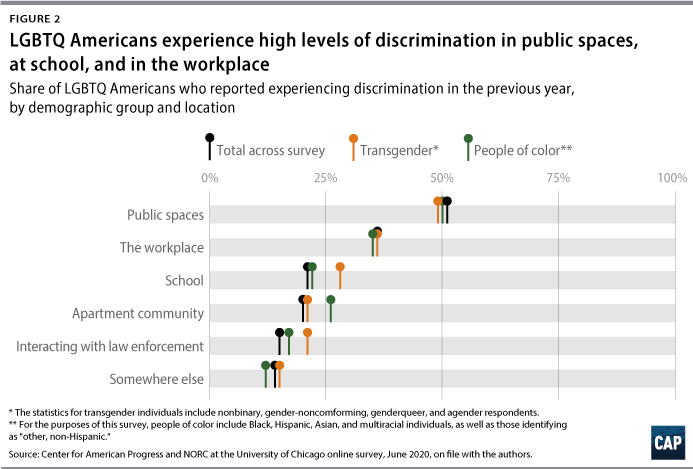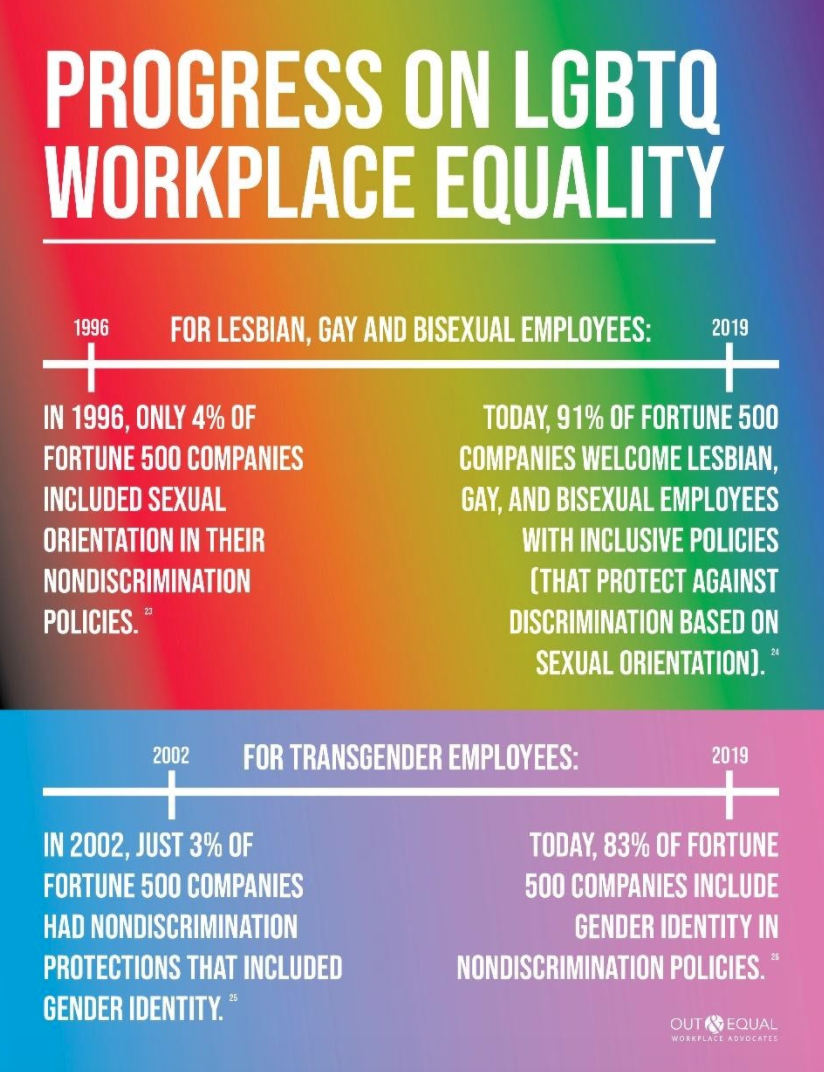This article has been written by an HR expert and global operations professional who considers himself as much of a student of people as a leader of them. The purpose of this article is to openly and directly address the often-misunderstood LGBTQ+-related terminology, the people it is designed to identify, and their general present-day workplace experience.
Building equity and inclusion requires awareness and understanding. We want people (e.g., managers, leaders, and all others) within the workplace (hopefully your workplace) to feel as though they have a better, more informed, and inclusive-minded grip on the many terms, encounters, and experiences that our LGBTQ+ co-workers and friends are at least partially defined by every day.
This article is not, by any means, an article that should be taken as an end-all resource to build organizational culture and programs upon. Rather, we hope that you consider it a beginning of a better understanding that leads to greater, more comprehensive culture building and training platforms within your organization. Since this is not a peripheral or listless topic within our workplace today, our collective learning and knowledge gathering should be unremitting.
For many of us, our workplace, although enjoyable at times, can lead to stress, anxiety, and uncertainty. If you can imagine for a moment, adding a significant berg of weight and unrelenting uncertainty of how you may be received by others around you, solely due to your sexual preference, gender identity, etc., you may begin to comprehend what some of our LGBTQ+ co-workers’ experience daily. It is only since the differing gender identities that many LGBTQ+ experience do not conform with social norms that this people group suffers in ways that others do not. This can, and is, being changed within America’s workplace — although not nearly as swiftly or apodictic as is needed.
What is LGBTQ+, its purpose, and meaning?
There are many ways to begin the discussion on LGBTQ+ meaning and its terminology’s do’s and don’ts, however we thought it would be best to dive right in at ground-zero with the use of the umbrella-acronym of “LGBTQ+.” This acronym (which some will consider out of date) refers to lesbian, gay, bisexual, trans, queer, and/or questioning, with the plus (+) sign which further signifies an actionable desire to be inclusive of all others.
To offer up another example that is gaining more common ground within LGBTQ+ communities, is an even longer, more explorative acronym of “LGBTQQIP2SAA”. This evermore precise acronym refers to lesbian, gay, bisexual, transgender, questioning, queer, intersex, pansexual, two-spirit (i.e., “2S”), androgynous, and a-sexual.
Said plainly, today’s workplace is not overly understanding of LGBTQ+ communities, and thus, struggles with the acceptance of LGBTQ+ community members.
Although this reality is rapidly evolving, there is a long path ahead for authentic diversity, equity, and inclusion (DEI) to truly win the day within every organization. With the growing DEI movement in America’s organizations today, it is becoming much easier to highlight areas for growth and improvement, when even five or so years ago, it was taboo to openly try to address LGBTQ+-related matters in the workplace.
Self-identifying pronouns: “he/him/his,” and “she/her/hers”
Another ubiquitous use of LGBTQ+ community-related acronyms include pronoun identification. If you frequent LinkedIn, Facebook, or other social platforms, you will have likely noticed the upsurgence of the use of pronoun self-identification titles. They look like they/them/their, he/him/his, and she/her/hers. Usage of this set or identifying pronouns is becoming more prevalent in professional and corporate social media circles, as well as within the increasingly visible LGBTQ+ community.
Why your business should care about LGBTQ+ employees and their workplace experience
To begin with, the marginalization that LGBTQ+ people have had to endure within the workplace has not only been unfair, but limiting and reductive by way of allowing people from this group fair advancement in career development as well as more general inclusiveness in the workplace overall.
Source: Center for American Progress
Societal numbers that are being reported out, which are probably conservative, can be tough to authentically absorb. Likewise, it can be particularly challenging to know how to best support this conglomeration of people groups within the workplace, particularly if a business is no outrightly discriminating against LGBTQ+ candidates and employees. Many companies desire to learn more about what can be done to support this group in the workplace and beyond (e.g., healthcare, benefits, etc.). The Center for American Progress reports several findings regarding the present-day LGBTQ+ community experience (which wholly translates to the workplace):
• More than 1 in 3 LGBTQ+ Americans experienced some form of discrimination of during the past year (this includes more than 3 in 5 transgender Americans).
• Discrimination adversely affects the mental and economic wellbeing of many LGBTQ+ Americans, including 1 in 2 who report moderate to significant negative psychological and health-related impacts.
• More than half of LGBTQ+ Americans report hiding a personal relationship, and about one-fifth to one-third have altered other aspects of their personal or work lives. Reportedly, these actions are taken to avoid discrimination or negative experiences.
Another reason for directing specialized attention at this people group stems from the fact that LGBTQ+ people, within society-at-large, experience mental health-related issues at a higher rate than people who do not find any identity within this expanding group. Thus, your workplace is impacted by these issues within this group, whether you realize (or choose to realize) it or not.
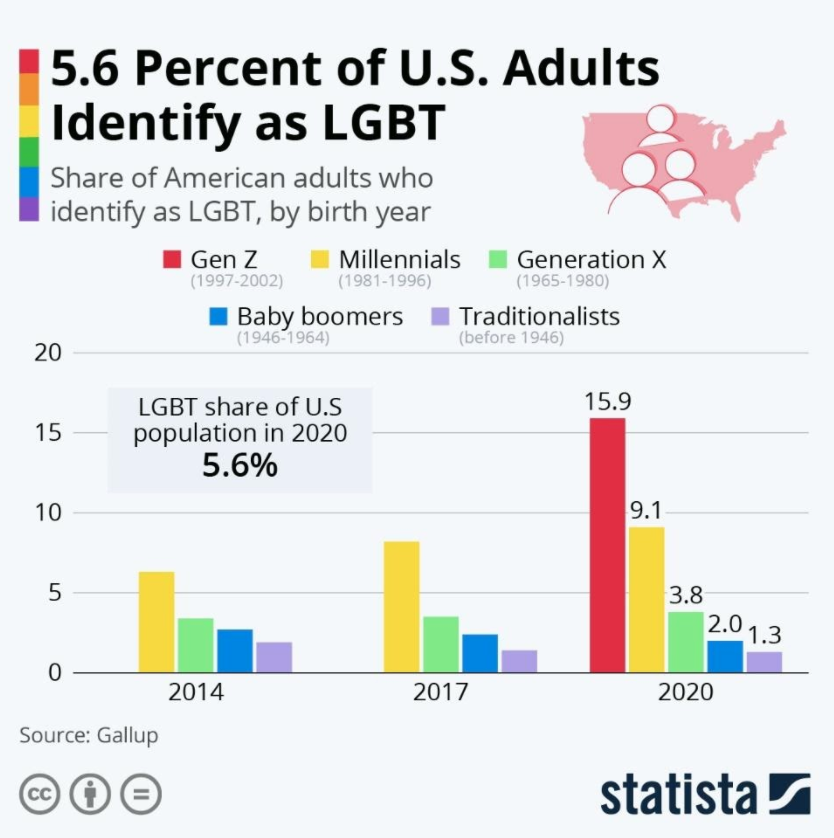
Source: Statista (note these statics represent how LGBTQ+ people have chosen to identify and whether to report out their status. This does not mean that there have been stark increases within the LGBTQ+ community at large. It is reported, as of 2020, that slowly but surely, more LGBTQ+ people feel more comfortable identifying publicly).
Beyond acquiring greater awareness regarding LGBTQ+ people within your workplace (which we take to mean, anywhere business is conducted, including with vendors, outside stakeholders, etc.) there are many states around the U.S. that are passing laws that are designed to better protect LGBTQ+ people, particularly within the workplace. It, then, stands to reason that workplaces around the U.S. will — and are being required to — alter their policies and workplace culture to more inclusively embrace the LGBTQ+ people within their workforce.
These changes at the state level are already creating a huge ripple effect through the business communities within several states. Likewise, this trend is placing heavier pressure on the states who have not yet acted. Although federal laws* to date have not been overly supportive, the reality that 52 percent of LGBTQ adults live in states, “…without explicit protections…” means when related cases are presented before the Supreme Court, the outcomes matter more than ever, not only for the LGBTQ+ community, but for workplaces across the country.
*Note that despite our earlier point, in June of 2020, the U.S. Supreme court upheld a 1964 Civil Rights federal law that forbids job discrimination on the basis of sexual orientation or transgender status.
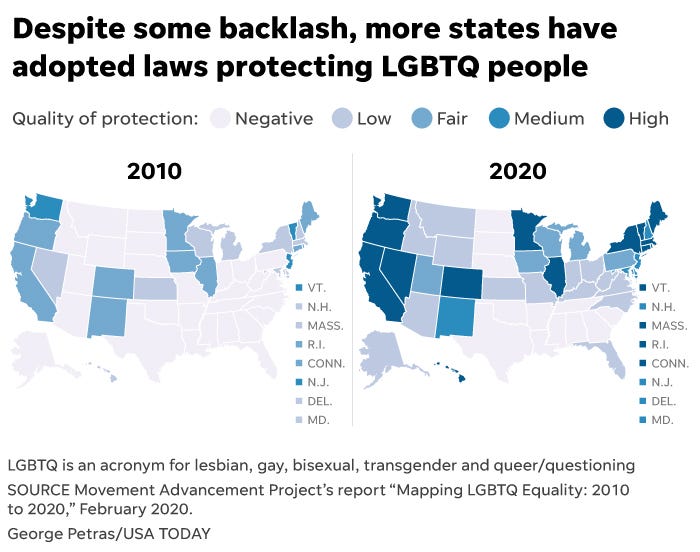
Source: USA Today
What is LGBT+ self-ID?
Where and when employers can do so, legally speaking, many businesses ask candidates who apply for jobs, as well as employees at times, to voluntarily disclose demographic information in categories that include disability, age, race, and gender. Despite this growing trend, far fewer actively gather sexual orientation and gender identity (SOGI) related data. Out Leadership notes that part of the reasoning why this is the case has to do with employers not being required to collect LGBT+ data on people they employ and who apply for their job opportunities. Employers often do not even know how to appropriately, professionally, and/or legally, acquire this information.
There are some, however, progressive-minded organizations, beginning around the mid-2000s, that have been collecting data relating to sexual orientation data. When companies cultivate a safe, inclusive, and equitable environment for all their employees, including LGBT+ personnel, the research tells us that, within the company’s LGBT+ workforce, there is better quality of work performed. Employees are also happier in their roles, are more likely to be promoted, and positively promote their employer to others.
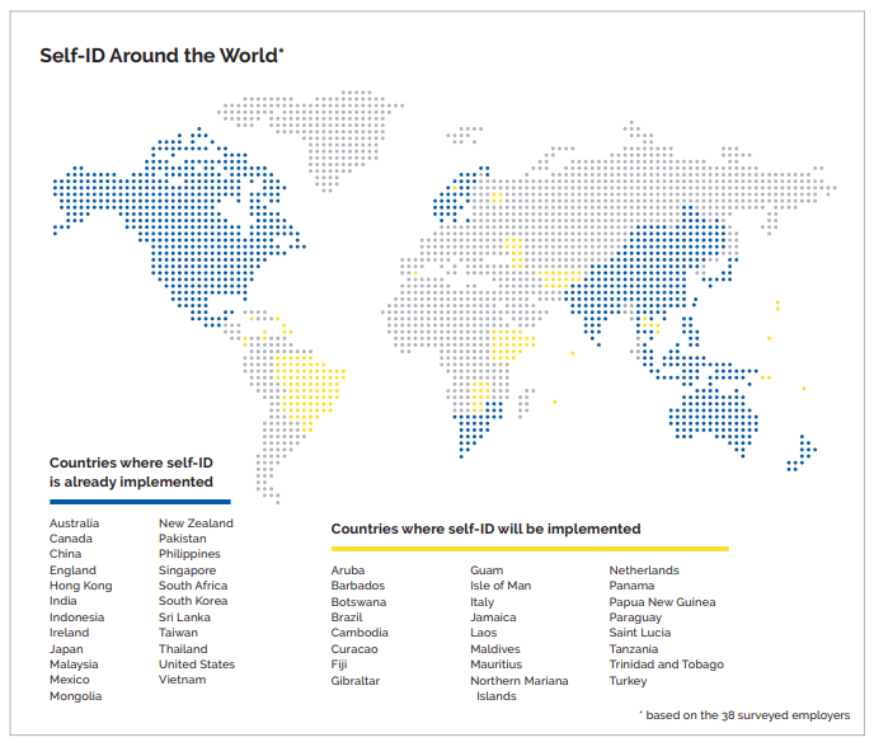
Source: Out Leadership
Diversity, equity, and inclusion (DEI) begins at the recruitment, hiring, and onboarding phases
One element of public policy and organizational recruitment strategies that need to evolve, quickly, is how companies recruit, interview, hire, and onboard LGBT+ candidates/new employees. We feel that this is where the LGBT+ community suffers the most within the professional or workplace theater. Equity to promotions and advancement and feeling as though you are a part of an inclusive team does not matter much if diversity itself is not a strategic priority for companies hiring.
“You can do a lot of things around inclusion, but you’re not going to get there if you have foundational issues with how you bring people in, onboard them, and retain them.” (A quote from a McKinsey study participant)
There are several actions and processes that a company can actively engage in that can help tip the balance even for qualified LGBT+ candidates (and employees). Following these eight steps listed below culminates in a solid beginning to organizational alignment with DEI priorities that should be imbued within every corporate strategy and team building initiative.
1. Clearly promote your intentions and desires
When you are being authentic about a cause, there is no “halfway.” The company either supports the plight of LGBT+ candidates and employees, or it does not. If your company is the former and not the latter, then place it on your company’s website (a “Careers” page is best).
2. Utilize resources that LGBT+ candidates’ access
If you truly desire a diverse pool of candidates, then utilize several different posting sites that are within the LGBT+ orbit.
3. Develop a welcoming candidate (and new employee) experience
Onboarding new employees is essential regardless of how your new employee self-identifies. With new LGBT+ team members, it is much more so the case. There are often natural concerns of acceptance, judgement, etc., floating around in your new employee’s head. If your company streamlines this welcoming process and the equity and inclusion part of your brand begins at the front door on the first day, you will have practiced what you have preached and have won an employee who is dedicated to your success.
4. Make diversity, equity, and inclusion part of your employer brand
There is something about a company brand that elegantly and effortlessly molds into its corpus the importance and priority of diversity, equity, and inclusion. The companies who do it well tend to draw forward-thinking job candidates, customers, business partners, stakeholders, etc. to them as though they are the source of a large focused gravity.
5. Train HR to assist, partner with, and guide those in need
Once onboarding begins and your teams become more diverse, do not kid yourself into thinking that everything “will just work out.” The fact is, managing a diverse workforce can be challenging at times and unique. Specialized training for managers and HR professionals is a particularly good idea. There is no shame in admitting that (1) you want your company to be authentic and learn more about LGBT+ people-groups, and (2) that you need help doing so.
6. Passively seek out LGBT+ candidates
Whether you presently have job openings or not, this is our general counsel to all employers – always be looking for new, top talent. This is also true to acquire and maintain a diverse workforce.
7. Show your company’s and brand’s pride
LGBT+ Pride month is the month of June. Be present in brand and management support (internally and externally). Companies do not have to spend a lot of treasure on this endeavor.
8. Do NOT fake it
Heed this sincere warning. There is real trouble lying in wait for companies who fake their way through these steps and include a layer within their brand that speaks to their fantom “DEI efforts.” If you are not ready for one or all of these suggestions, simply admit it to yourself (and to your senior leadership team). Then, get busy catching up to the thinking that everyone has an equal right to access and enjoy their vocational journey in any and all businesses who hire employees. Refer back to #5 and start placing one foot in front of the other regarding this matter. And make haste.
Source: The Center for American Progress
Gender and LGBTQ+ discrimination
When we factor in gender-specific discrimination in the workplace and apply it, or overlap it with the LGBTQ+ communities, then it is easier to see how discrimination moves so freely within American companies (as well as many companies around the world). People who choose to do so, can cleverly cloak their disapproval, and acts of discrimination of LGBTQ+ employees in creative ways. Namely, pointing at inconsequential lack of specific experience, gaps in employment, gender-biased emotional or personality types that are, in fact, imaginary, and so on.
LGBTQ+ women, for example, are forced to manage workplace discrimination more so than LGBTQ+ men. We also know, just to point to the bright side, that when LGBTQ+ employees feel safe enough to reveal who they are, good things happen. McKinsey and Company report that when women who are out (or who have “come out”) as LGBTQ+ in their workplace, they are far happier with their careers, and “…view both their companies and their managers more favorably compared with their closeted peers.”
The trans (or gender-diverse) experience in the workplace
Although not the same for everyone, many, if not most, trans employees suffer silently within the workplace. Reconciling with oneself in this manner can be difficult for some internally, which is made more complex when there are external measures of judgment and rejection. Just so we are clear, gender-diverse co-workers are people who identify with a gender other than the one assigned at birth. There are also times when trans people identify with multiple genders, or no gender — including trans, genderfluid, genderqueer, and gender nonconforming, and so on.
As we noted earlier, the landmark Supreme Court case Bostock v. Clayton County, decided in June 2020, confirmed and reestablished that federal law prohibits anti-transgender discrimination in the workplace. Since there are an estimated 1.4 million adults in the United States who identify as trans, this has been big news. Although this will look different for every workplace, companies must begin, if they have not already, looking for ways to effectively embrace and include trans employees within their teams and provide equal access to opportunities.
The two primary business-centered reasons to get on board with supporting trans people in your workplace, as well as LGBTQ+ people-at-large, are twofold. First, as reflected in the image below, many companies, businesses, and organizations around the country have caught a clue, and have begun taking this matter seriously.
The second business-centered reason for catching your organization up on LGBTQ+ rights and the issues these communities deal with has to do with the fact that it has become good for business. (Yes, I wrote it, and you read it.) The fact is that a growing number of Americans (68 percent and increasing rapidly) report that they are likely to shop, or support, a business that makes a public stance in support of LGBTQ+ rights and equality.
The bottom line is simply that actively, deliberately, and publicly supporting the LGBTQ+ community within your business (even if that “community” consists of a single person) is a mandatory strategic initiative that you will have to arrive at in order to experience long-term, sustained success in your business.
Even though that sounds dramatic, we will further note that companies who do not decide to make this move, will slowly, yet unintentionally place themselves in the spotlight of public opinion, where it will be determined that your business cannot fully accept all citizens within society. As such, slowly but surely, society will minimize that business by withholding resources, opportunities for business growth, and profit.
At its heart, the only thing being asked of companies at large is equity and inclusion for all people in the workplace. LGBTQ+ people are not asking for above and beyond, just what others have by way of acceptance, fellowship, and opportunity.
ForceBrands offers end-to-end hiring solutions for all stages of growth. Whether you’re just starting to hire or are looking for the next step in your career, we’re here to help you be a positive Force that makes an impact.
